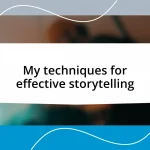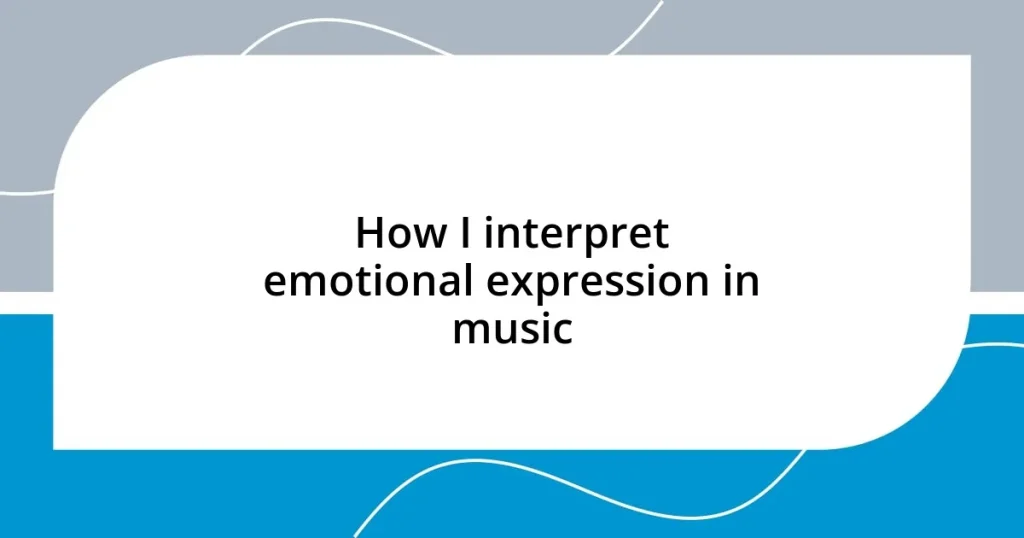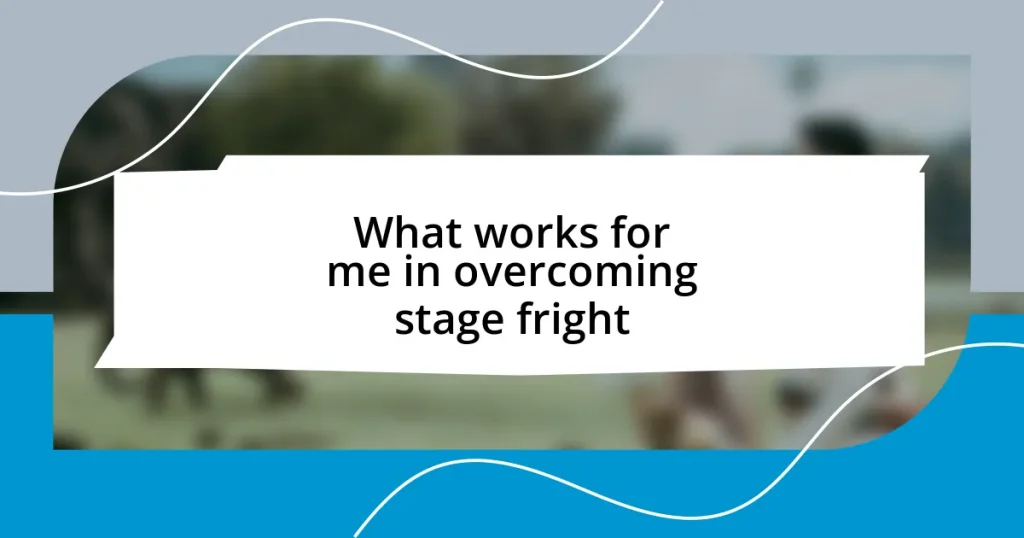Key takeaways:
- Music serves as a mirror to emotions, allowing personal reflection and processing of feelings through its emotional depth.
- The interpretation of lyrics can vary based on context, revealing personal connections and enhancing understanding of themes.
- Cultural influences shape emotional responses to music, with traditional sounds evoking distinct communal experiences and memories.
- Techniques like active listening and engaging in communal settings amplify emotional connections, fostering shared experiences through music.

Understanding emotional expression in music
I’ve often found that music holds a mirror to our emotions. For instance, I remember listening to a poignant piano piece that instantly made me reflect on a personal loss. The way the notes rose and fell seemed to echo my own feelings of heartbreak, making me wonder how a composer could capture such depth with just a few chords.
Emotional expression in music resonates on levels we often don’t realize. Have you ever felt an upbeat song lift your spirits, even when the lyrics are bittersweet? It’s fascinating how the juxtaposition of lively instrumentals paired with melancholic words can create a whirlwind of emotions, allowing us to process our feelings in a unique way that speaks to our experiences.
The connection between music and emotion is deeply personal yet universal. I recall my college days, where listening to certain tracks became a ritual before exams. The intensity of the music helped me channel my anxiety into focus, illustrating how melody and rhythm can guide our emotional landscape. Isn’t it incredible how a single song can evoke memories and feelings we thought were long buried?
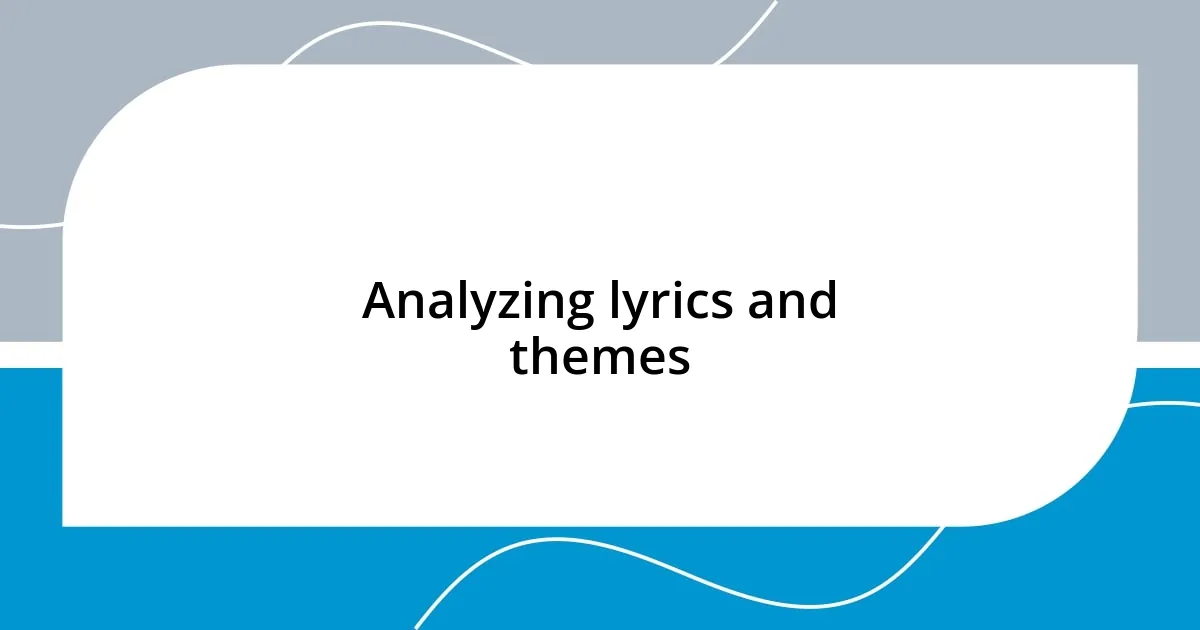
Analyzing lyrics and themes
Analyzing lyrics is like peering into the heart of a song. I vividly recall the first time I heard a song that spoke directly to my struggles with self-doubt. The lyrics painted a picture of vulnerability that resonated deeply with me; I felt as though the artist had reached into my mind and articulated what I couldn’t express. Lyrics often function as a narrative thread that illustrates a theme, making listeners reflect on their own lives.
When exploring themes, the emotional impact can shift dramatically depending on context. For instance, I’ve listened to a ballad exploring love and loss while curled up on my couch, and the emotions felt starkly different from when I experienced the same song in a live concert setting. That difference made me realize how the environment and my emotional state can alter my interpretation of the themes presented in the music, revealing layers of meaning I hadn’t considered before.
Moreover, the power of metaphor in lyrics can create a deeper emotional connection. I once deciphered a song where the artist used the metaphor of a storm to signify turmoil. As I navigated a particularly turbulent time in my life, the imagery resonated so profoundly that it provided clarity and comfort. It reminded me just how important it is to analyze not just words, but the stories they tell and the emotions they evoke in the listener.
| Aspect | Example |
|---|---|
| Vulnerability | A song expressing self-doubt that resonates deeply |
| Contextual Influence | A ballad’s emotional impact differs at home vs. at a concert |
| Metaphorical Depth | A storm used as a metaphor for personal turmoil |

Recognizing cultural influences on emotion
Recognizing cultural influences on emotion in music is incredibly intriguing to me. Each culture brings its unique emotional palette, colorfully shaping how music is created and interpreted. When I listen to traditional folk songs from different regions, I can often sense their historical and social contexts, revealing emotions tied to communal experiences. For instance, hearing a rousing Irish jig evokes feelings of celebration and resilience, while a melancholic blend from the Highlands may reflect a narrative of longing and loss, deeply rooted in the landscape and social history.
- Cultural Context: The understanding of emotions can shift based on cultural background, as seen in various musical genres.
- Traditional Instruments: Listening to unique timbres, like the sitar or djembe, can evoke specific emotional responses tied to their cultural origins.
- Ritual and Ceremony: Music often accompanies rituals, enhancing feelings of connection and shared experiences, which vary dramatically across cultural lines.
I remember attending a world music festival where I first encountered music from the South African tradition. The joyous rhythms and call-and-response style had an infectious energy that made the crowd feel like one big family. It was enlightening to see how deeply the music resonated with everyone, transcending language barriers and stirring a shared emotional experience.

Personal experiences with emotional music
One of my most memorable experiences with emotional music happened during a late-night drive. I turned on a hauntingly beautiful song that captured a mix of nostalgia and longing. As the melody filled the car, it felt as though the lyrics were weaving through my memories, unlocking feelings I hadn’t acknowledged in a while. I found myself reflecting on moments from my past that I thought I had moved on from, yet the music gently brought them back to life, evoking both tears and a sense of catharsis.
On another note, I remember attending a small acoustic set where the singer shared the backstory of each song. One particular song about heartbreak became a vessel for shared pain. As I looked around, I noticed others nodding in understanding, and I could feel a collective sense of camaraderie. Isn’t it astounding how music can unite strangers through vulnerability? In that moment, I felt not only my own sorrow but also the emotional echoes of those around me, creating a shared experience that transcended individual struggles.
Then, there are times I come across a playlist designed for relaxation or meditation. One evening, I decided to immerse myself in such a collection while winding down for the day. As each note washed over me, I could feel stress fading away, replaced by serene acceptance. It prompted me to ask myself: how can something as simple as sound evoke such profound peace? The answer lies in the pure emotion conveyed through melody and rhythm, reminding me that music isn’t just heard; it’s felt deep within our very being.
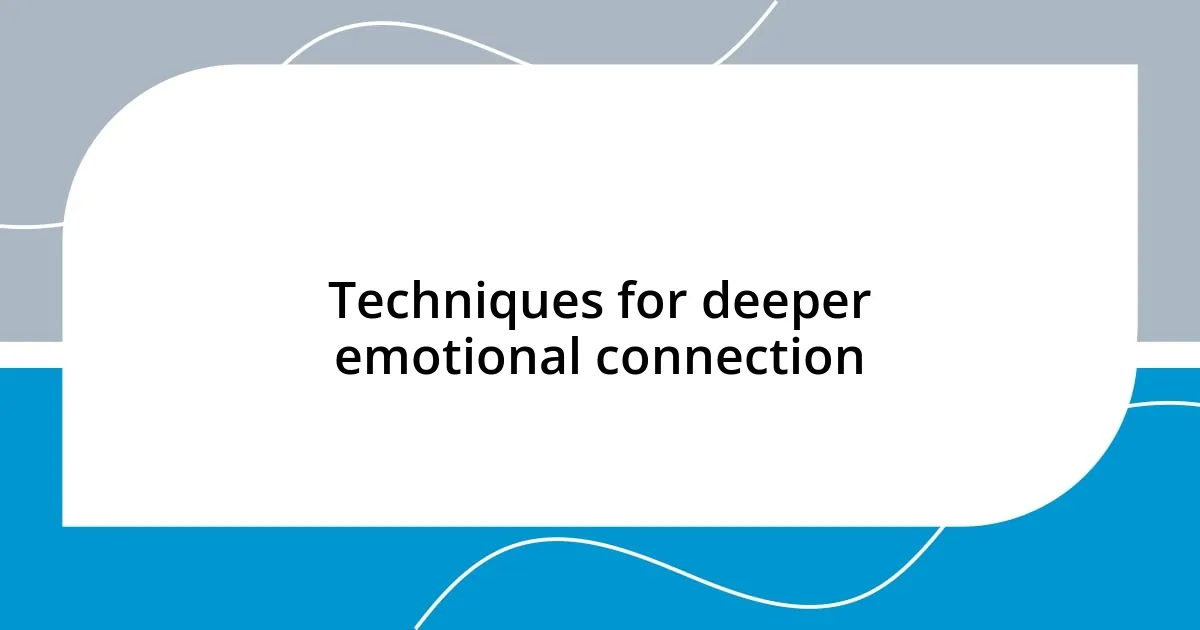
Techniques for deeper emotional connection
One technique for fostering a deeper emotional connection with music lies in active listening. I’ve found that truly immersing myself in a song—allowing each note to resonate with my feelings—can transform my experience. For instance, during a particularly challenging week, I chose to revisit an album that once comforted me. By focusing on the lyrics and instrumentation, I noticed how each piece echoed my state of mind, as if the artist had captured my experiences in sound. Have you ever had a moment where a song just seemed to “get” you? I cherish those moments, as they make me feel less alone.
Another approach is exploring the stories behind the music. Recently, I attended a virtual concert where the artist shared personal anecdotes about their songwriting process. Suddenly, the songs took on a new life for me; the emotions expressed were no longer abstract but tied directly to the artist’s experiences. It made me wonder: how often do we overlook the background of a song? Understanding the context can deepen our connection and enrich our appreciation for the emotional layers woven into the music.
I also believe that engaging with music in a communal setting can amplify emotional resonance. The last time I went to a live gig, I felt a unique energy in the air as the crowd sang along. In that moment, I realized we were all sharing our individual emotions, creating a vibrant tapestry of feelings. Isn’t it fascinating how music can turn a group of strangers into a united front of shared experience? Those collective moments not only heighten my emotional connection to the music but also to the people around me, making each performance unforgettable.







